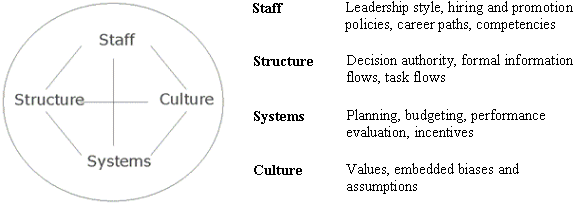|
|
| Home - Industry Article - Apr 06 Issue |
Achieving Breakthrough Growth: From Ideas to Execution
continued... page 2 |
The only way to forget, borrow, and learn, is to alter the set of policies that have the greatest influence over behavior – that is, to alter its organizational DNA (Figure 2). All organizations have DNA. When small companies get big enough that the leader can no longer make all of the decisions, the leader starts to create DNA – by establishing policies, decision rules, incentives, values, and more. A strong organization has a DNA that is consistent with its business model – but this means that the same DNA will get in the way of a new business. An organization's weaknesses are just the flip side of its strengths. Hard-wire an organization to excel in one business, and it is almost certain to struggle in a different one.
Figure: 2 The remaining nine rules (Figure 3) represent a more specific blueprint for using the distinct-but-linked design to forget, borrow, and learn. There are three rules for each challenge.
The remaining nine rules (Figure 3) represent a more specific blueprint for using the distinct-but-linked design to forget, borrow, and learn. There are three rules for each challenge.
Figure: 3 To forget, NewCo must rebuild its DNA from the ground up. Outside hires play a crucial role because they naturally challenge existing assumptions everyday. To be effective, outsiders must be placed in influential positions. In addition, NewCo should report at least one level above the general manager of CoreCo. When NewCo reports to CoreCo, CoreCo has too much influence. Performance measures must also change, because they are very strong reinforcers of existing behaviors and mindsets.
To forget, NewCo must rebuild its DNA from the ground up. Outside hires play a crucial role because they naturally challenge existing assumptions everyday. To be effective, outsiders must be placed in influential positions. In addition, NewCo should report at least one level above the general manager of CoreCo. When NewCo reports to CoreCo, CoreCo has too much influence. Performance measures must also change, because they are very strong reinforcers of existing behaviors and mindsets.
NewCo must be exceedingly cautious about how much it attempts to borrow. Each link between NewCo and CoreCo makes it more and more difficult for NewCo to forget. NewCo should borrow only when doing so gives NewCo a crucial competitive advantage, never just for incremental cost savings. Links must not only be carefully selected, they must be carefully managed.
Tensions between NewCo and CoreCo are inevitable, and the senior management team must recognize that keeping these tensions at productive levels is the most crucial thing they can do for NewCo once it is launched. An important step for ensuring tensions remain at healthy levels is to make borrowing as easy as possible for CoreCo. The general manager of CoreCo is responsible for the business that is at the foundation of the corporation's ongoing performance, and he or she should not be distracted by an experimental new unit. To make borrowing painless, CoreCo's resources should be increased where NewCo demands time and attention. Also, transfer prices should properly correct CoreCo's reported income.
NewCo has a very focused learning challenge: It must learn to predict its own business outcomes. The quicker it gets better at forecasting its own performance, the faster it resolves the critical unknowns in its business model, and the more quickly it will zero in on a winning formula, or exit a losing business. When NewCo is learning, wild guesses become informed estimates, and informed estimates become reliable forecasts.
Predicting is the activity at the core of the planning process, so all of the rules for learning are alterations to the traditional approach to planning. Most crucially, the senior management team must hold NewCo accountable for learning, not for delivering the numbers in the plans. Predictions can't improve if plans can't change! Still, this is a difficult shift for senior managers who often connect strong performance with strong accountability.
The opposite of accountability to plan, however, is not chaos. It is a disciplined, structured, and rigorous approach to learning. One crucial attribute of a planning process that supports learning is that it iterates more frequently. NewCo's plans should be revised quarterly, or even monthly – and thus plans must be simplified to make this practical. Finally, NewCo's and CoreCo's planning meetings should be separate. Otherwise, there are too many conflicting interests and assumptions in the discussion.
With a distinct-but-linked approach, even the most tradition-bound organizations can get beyond just ideas. They can build new businesses of the future by forgetting, borrowing, and learning.
Vijay Govindarajan is a Professor at Tuck School of Business, Dartmouth College. He has been recognized by BusinessWeek, Forbes, Across the Board, and The London Times as a top thought leader in the field of strategy.
Chris Trimble is also on the faculty at the Tuck School, and has published in the Harvard Business Review, MIT Sloan Management Review, California Management Review, and Across the Board. Chris is also a Senior Fellow at Katzenbach Partners LLC.
Both authors recently published "Ten Rules for Strategic Innovators: From Idea to Execution", Harvard Business School Press, 2005. For article feedback, the authors can be reached at vg@dartmouth.edu and chris.trimble@dartmouth.edu
 

|
|


|

